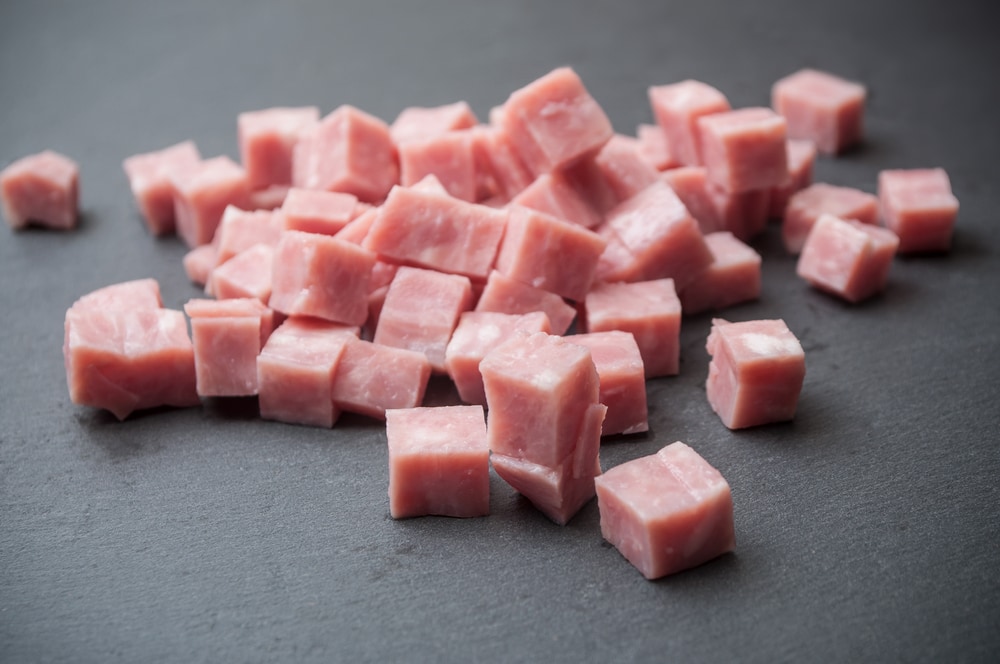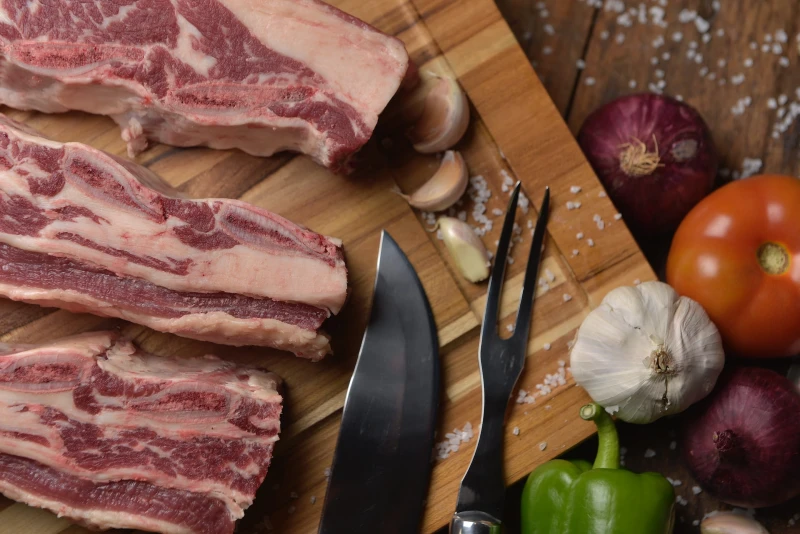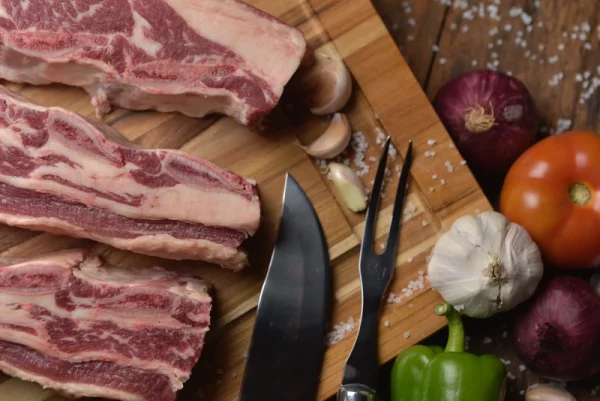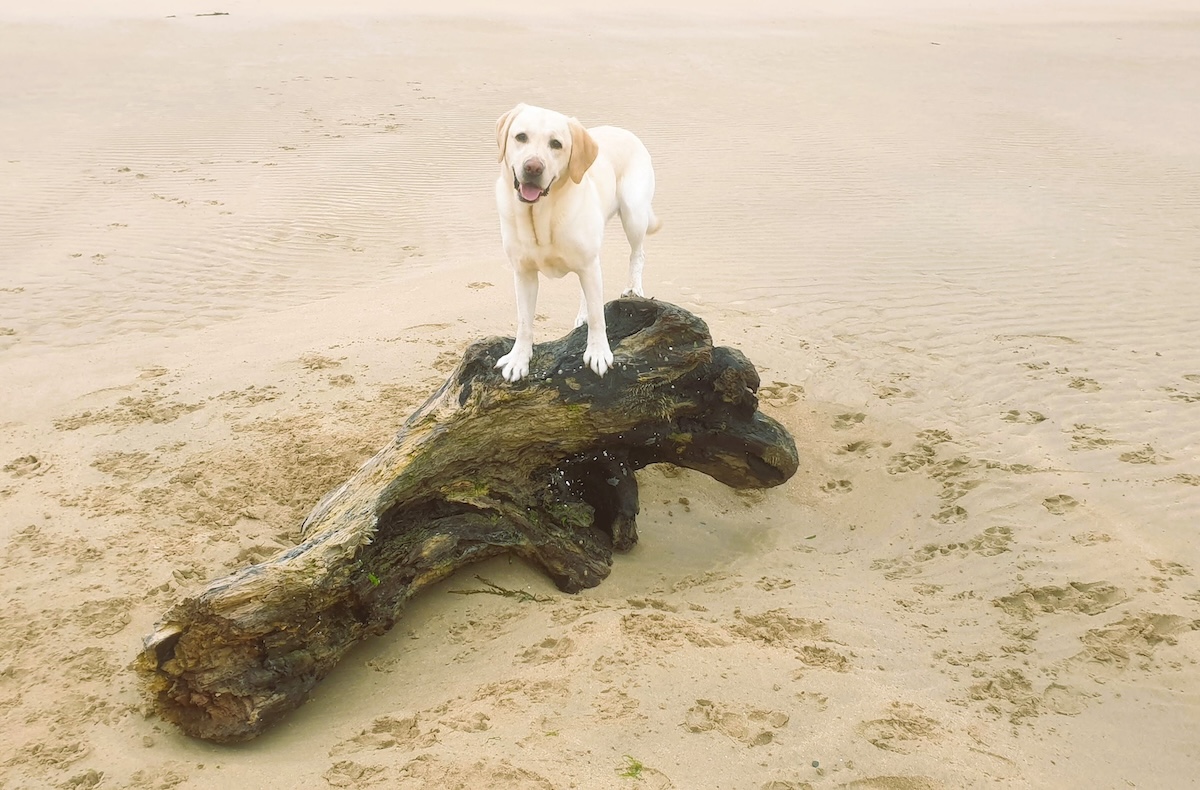Click to Skip Ahead
There is always a time for pork, whether it’s crispy bacon to accompany your waffles, pork sausages for lunch, or a pork roast with all the trimmings for a special occasion; there are many opportunities where pork can get your dog salivating. But can dogs eat pork?
Although chicken and beef are the most popular proteins to give your dog, dogs can also eat pork.
However, there are a few things to consider before introducing pork to your dog’s diet because it can come in various forms and needs to be cooked properly. To assist you in making an informed decision, we’ll discuss which types of pork are unsuitable and how to feed pork to your dog.
Can Dogs Eat Pork?
Pork can take the form of ham, bacon, salami, steak, chops, belly, and ribs, to name a few. You can typically give your dog pork as long as there is no seasoning, condiments, sauces, or ingredients that cause harm to your dog, such as onions.
Pork generally has a high-fat content, so it’s best to serve it occasionally rather than as part of your dog’s regular diet. However, if you want to give your dog a piece of pork, it’s always to consult with your veterinarian beforehand. Introducing new food can cause an upset stomach in some dogs, and your vet can advise you whether it’s a suitable treat for your dog based on their weight, age and any underlying health concerns or special diet requirements they have.

Risks of Feeding Processed Pork
Processed pork, like salami and ham, has been treated to preserve and flavor it. This is done by salting, fermenting, smoking, or curing. While these processed meats are not entirely unsafe for your dog, they’re better to avoid since they are not the healthiest options.
Most dogs love bacon, but it’s loaded with salt and fat. Rich and fatty foods with a high salt content can be hard on your dog’s digestive system. Eating high fat foods can also put your dog at risk of pancreatitis, a painful and serious condition.
Cooked, plain pork is safe for dogs, and instead of processed meat, you can cook a pork loin or pork chops (without the bones). However, some pork is pre-seasoned and contains harmful ingredients, such as garlic, onion powder, and nutmeg. Pre-seasoned meats also contain large amounts of sodium and sugar. These should be avoided.
Dangers of Raw Pork
Raw or undercooked pork is not safe for your dog or humans. Raw pork carries the risk of having Trichinella spiralis larvae, which can lead to the parasitic infection trichinosis. As the parasite migrates into the muscles, it causes severe muscle inflammation. Puppies are more susceptible to trichinosis than adult dogs.
- Upset stomach
- Diarrhea
- Vomiting
- Lethargy
- Muscle inflammation
- Muscle stiffness

FAQ About Dogs Eating Pork
Can Dogs Eat Pork Bones?
It’s always tempting to feed our bones to our dogs after a meal, but they could cause significant harm. When bones are cooked, they become very dry, which causes them to become fragile and brittle. When a bone is brittle, it can easily splinter, which can damage your dog’s internal organs and esophagus.
Your dog can also easily choke on bones, even uncooked ones. Instead of giving your dog bones from your dinner, offer dog-safe dental bones or chew toys to satisfy their urge to chew.

How Much Pork Can I Give My Dog?
If you want to feed your dog pork, you should only offer cooked, plain pork, occasionally in small portions. Try to avoid processed pork like ham, bacon, and salami. When giving your dog pork for the first time, serve a very small amount and monitor your dog for any reaction. As with other protein sources, pork can cause food intolerances or food allergies in some dogs.
Are There Any Benefits to Feeding My Dog Pork?
Pork can be a tasty treat for your dog and provide some health benefits, but as we mentioned before, it should only be offered to your dog as a treat.
- Good source of protein, which helps to build and maintain strong and healthy muscles
- Rich in thiamine (vitamin B1) and vitamin B12.
- Usually highly palatable and can be used to disguise pills for dogs that refuse to eat them

Which Meat Is Best for My Dog?
Chicken and beef are the most common meats in commercial dog food, and when prepared without seasoning and cooked thoroughly, they’re healthy treats for dogs. Chicken is high in protein, low in saturated fat, and is easy on the digestive system ( unless your dog has a food allergy to it!). Dogs tend to love beef because it’s high in protein, but it costs more than chicken.
Fish is another great protein that dogs love. Salmon is the most commonly used fish in dog food since it is high in protein and includes essential fatty acids that your dog needs in its diet.
Due to its very similar nutritional profile to chicken, turkey is another lean meat often used instead of chicken in dog food.
Other great meat sources for your dog are lamb, duck, and organ meat. It is important to remember that whichever protein you choose for your dog, the meat should always be cooked well; raw or undercooked meat can carry bacteria that can make your dog ill.
Conclusion
Cooked plain pork is safe for your dog to eat, but you should avoid feeding your dog processed, seasoned, or basted pork and pork bones. Raw pork can pose some health risks for you and your dog, so if you feed your dog pork, ensure it is cooked very well. Your veterinarian is your best source of information when it comes to adding food to your dog’s diet or changing it, so if you are considering offering your dog pork, it’s best to contact your veterinarian first.
Featured Image Credit: Lucas Vinicius Peixoto, Unsplash










